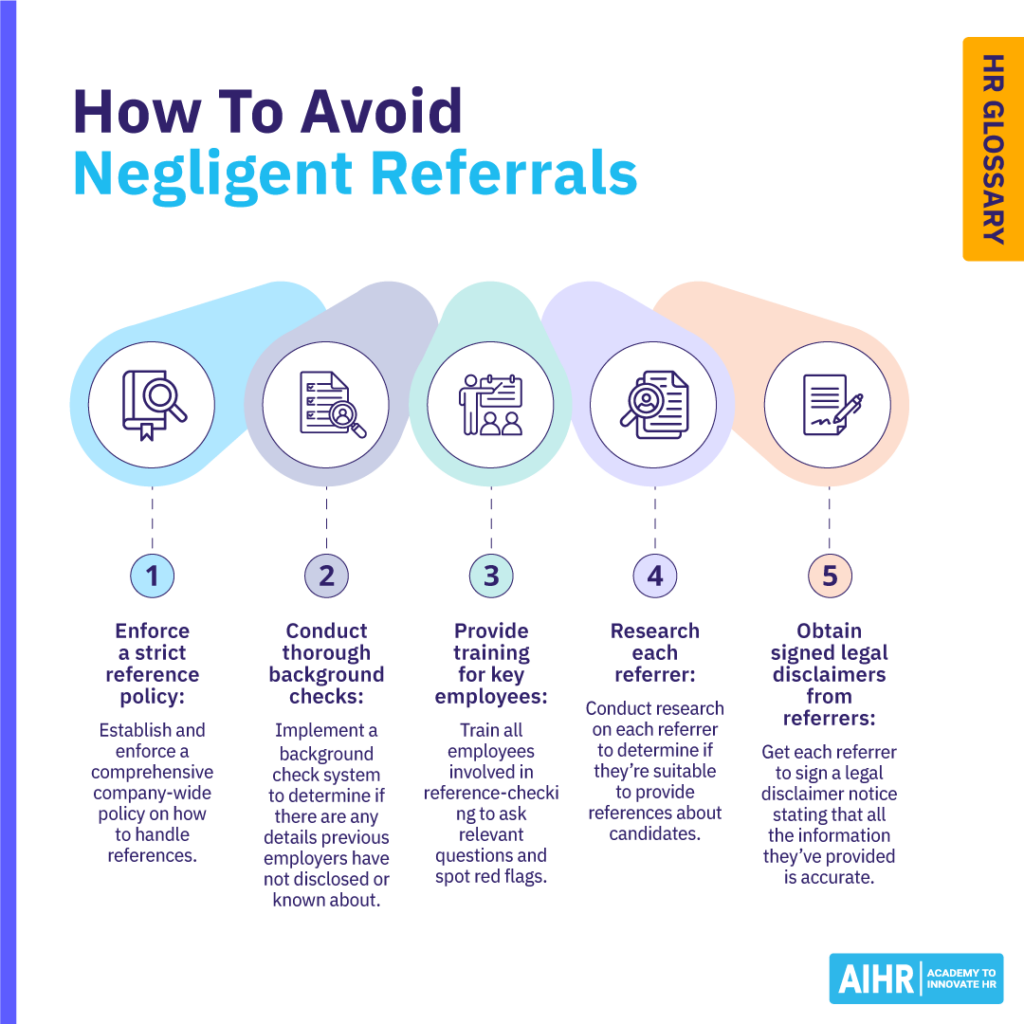Negligent Referral
What is a negligent referral?
A negligent referral occurs when an employer gives inaccurate or misleading information about a former employee to a prospective employer. This can involve omitting relevant details about the employee’s past performance or behavior that could harm the prospective employer.
Employers have a ‘duty of care’ to give accurate and honest references, which means they must share critical information that could impact hiring decisions. Former employers can be held liable for negligent referrals if proven to have knowingly provided false information or withheld critical details about an ex-employee’s suitability for a position.
What is negligent hiring?
Negligent hiring is when an employer hires an unsuitable candidate, knowing they pose a safety or other security risk in the workplace. The employer can be held liable for any accident or harm the employee causes, especially if it’s proven that they failed to conduct proper vetting or background checks during the recruitment process.
Negligent hiring and negligent referral are related as they both involve an employer’s failure to follow standard hiring practices, which can result in negative consequences for an organization and its workforce.
How do negligent referrals affect employees?
Negligent referrals can negatively impact the referred employee, their team members, and the organization. Here are some of the consequences employees may face as a result of negligent referrals:
- Reputational damage: A referred employee’s professional reputation could suffer, especially if misleading or false information about their character, behavior, skills, or experience affects the quality of their work and their professional relationships.
- Lowered trust and morale: If colleagues and management discover negligent referrals, it can lead to a lack of trust in HR and the organization’s hiring processes, impacting morale among teams and departments.
- Missed career opportunities: A negligent referral could unfairly deny a qualified candidate or internal hire a new job or career advancement opportunity.
- Sub-par performance: An unsuitable or unqualified employee can greatly impact the overall job performance and productivity of their team members. This could also increase the workloads of colleagues who try to compensate to maintain performance standards.
- Emotional or physical harm: When a referral fails to mention prior emotional or physical abuse in the workplace, colleagues, clients, and key stakeholders could face a safety risk at work.
Prevent hiring risks with a structured referral process
Negligent referrals can seriously affect organizations, from legal liabilities to damaged reputations. A solid approach to reference checks is essential to minimize risks and ensure safe hiring practices.
With AIHR’s Sourcing and Recruitment Certificate Program, you’ll learn how to develop robust recruitment processes, including how to vet referrals and conduct thorough background checks, ensuring you make informed hiring decisions every time.
How do negligent referrals affect employers?
Both employers who provide negligent referrals and those who hire based on them may face several negative consequences. These include:
- Legal liability: An employer may face legal repercussions if they provide false or misleading information in a referral or are found to have knowingly engaged in negligent hiring.
- Damage to employer branding: An employer’s credibility and reputation may suffer if they become known for giving negligent referrals or engaging in negligent hiring. HR professionals may also choose to avoid hiring candidates from organizations with a reputation for providing negligent referrals.
- Decreased productivity: Negligent hiring can result in poor job performance and decreased employee motivation, lowering overall organizational productivity.
- Organizational safety risk: A new hire with an undisclosed history of bad behavior or physical violence may put other employees at risk. In certain cases, an unqualified employee can present a safety hazard and wind up causing accidents or injuries.
- Higher recruitment costs: Hiring an unsuitable candidate for a role can significantly increase recruitment budgets. If they perform poorly and are terminated, the organization must bear the costs of hiring a replacement.
5 steps to avoid negligent referrals
Here are five effective steps HR teams can take to prevent negligent referrals:

- Enforce a strict reference policy: Establish and enforce a comprehensive company-wide policy on handling references, including key guidelines on obtaining accurate, honest information on referrals. Ensure the process of providing referrals is well-documented and widely communicated beyond HR teams.
- Conduct thorough background checks: Beyond professional references, implement a background check system. This can be especially useful to determine if there are any details previous employers have not disclosed or known about.
- Provide training for key employees: Share your expertise on obtaining references with all employees involved in the reference-checking process. Train them to ask relevant questions about every candidate’s background, skills, and previous experience, as well as to spot red flags.
- Research each referrer: Conduct research on each referrer to determine if they’re suitable to provide details about candidates. This will help you avoid receiving information from unsuitable individuals.
- Obtain signed legal disclaimers from referrers: Get each referrer to sign a legal disclaimer notice stating that all the information they’ve provided is accurate. Making referrers aware of the consequences of potential legal liability for providing false or misleading statements can be a good deterrent against negligent referrals.
HR tip
In addition to the above steps, check in with each new hire’s manager within the first three months of their employment. This could help identify any inconsistencies or red flags early on. You could formalize this process by developing a standard template of specific questions about the new employee’s competencies, performance, and behavior.
Managing referrals: Best practices for HR
When it comes to managing referrals, here are some best practices to keep in mind:
- Standardize the reference process: Implement a clear, consistent referral process your HR team can use for all candidates. Although some roles may need more extensive background checks, there should be a standard process everyone must follow. This helps you apply identical criteria to all referrals, treating them fairly and consistently.
- Verify each referrer’s identity: Before contacting each referrer, confirm they are who they say they are. Conduct a simple search to confirm their name, job title, history at the company, and relationship with the candidate in question. Next, ensure all referrals are strictly vetted.
- Maintain timely, meticulous documentation: Keep thorough written records of all reference requests and responses. Every reference should clearly document a candidate’s prior job performance and work history, as well as the name and contact details of their referrer. Make it a practice to obtain written references instead of only verbal confirmations.
- Consider a third-party reference/background check service: Depending on your organization’s size and the resources available to your HR department, you may want to engage a third-party reference service. It can conduct and manage references and help vet final candidates impartially.
FAQ
A negligent referral refers to when an employer provides inaccurate, misleading, or incomplete information about a former employee to a prospective employer. This can involve not disclosing relevant information about the employee’s behavior or actions that harm their prospective employer.
An example of a negligent referral is a former manager referring an ex-employee without disclosing their history of workplace bullying. Failing to inform a prospective employer of this history during a reference check could result in legal consequences for the former employer.









